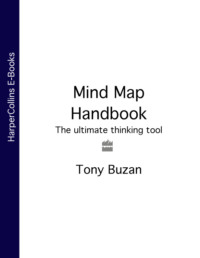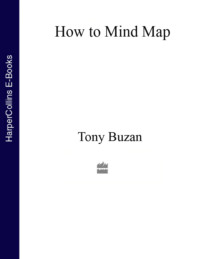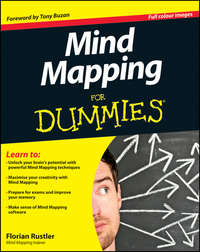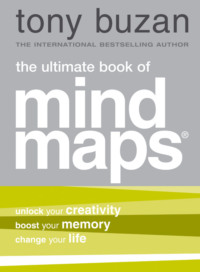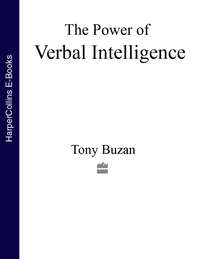
Полная версия
The Power of Creative Intelligence: 10 ways to tap into your creative genius


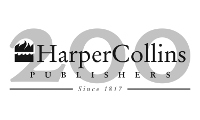
Copyright
Thorsons
An imprint of HarperCollinsPublishers Ltd.
1 London Bridge Street
London SE1 9GF
www.harpercollins.co.uk
First published 2001
Copyright © Tony Buzan 2001
Mind Maps® is a registered trademark of the Buzan Group Original Mind Map concept © Tony Buzan
A catalogue record for this book is available from the British Library
Plate section illustrations by Alan and Emily Burton
Text illustrations by Alan Burton and Jennie Dooge
Tony Buzan asserts the moral right to be identified as the author of this work
All rights reserved under International and Pan-American Copyright Conventions. By payment of the required fees, you have been granted the nonexclusive, non-transferable right to access and read the text of this ebook on screen. No part of this text may be reproduced, transmitted, downloaded, decompiled, reverse engineered, or stored in or introduced into any information storage retrieval system, in any form or by any means, whether electronic or mechanical, now known or hereinafter invented, without the express written permission of HarperCollins ebooks
HarperCollinsPublishers has made every reasonable effort to ensure that any picture content and written content in this ebook has been included or removed in accordance with the contractual and technological constraints in operation at the time of publication
Source ISBN: 9780722540503
Ebook Edition © MAY 2017 ISBN: 9780007499526
Version: 2017-06-15
Dedication
The Power of Creative Intelligence is fondly and warmly dedicated to Lesley and Teri Bias; my mum, Jean Buzan; Lorraine Gill, Vanda North, Nicky and Strilli Oppenheimer, Dr Petite Rao, Caroline Shott and Carole Tonkinson for their creativity, dedication and hard work in making this little book come true.
Contents
Cover
Title Page
Copyright
Dedication
Chapter 1: Introduction – Beginning Your Creativity Journey
Chapter 2: Using Your Magical Left and Right Brains
Chapter 3: Infinite Creativity – Mapping Your Mind with Mind-Maps®
Chapter 4: You the Creative Artist
Chapter 5: You the Creative Musician
Chapter 6: Creative Productivity – The Power of Volume and Speed
Chapter 7: Creative Flexibility and Originality
Chapter 8: Your Brain: The Ultimate ‘Association Machine’ – Expansive and Radiant Thinking
Chapter 9: You and Shakespeare – Poets Both!
Chapter 10: Only Kidding
Congratulations!
Keep Reading
Acknowledgements
About the Author
Other Books By
About the Publisher
do you/did you/are you/would you?!
How creative do you think you are? To get some (probably surprising) idea of your own creativity, consider the following questions, and ask yourself:
1. Do you daydream? YES/NO
2. Do you plan menus and cook meals for yourself, your family or friends? YES/NO
3. Do you mix and match colours, fabrics and accessories when buying clothes to create your own unique style? YES/NO
4. Do you like many different kinds of music? YES/NO
5. Do you remember with pleasure, highlights of your life, including special times spent with friends, great sporting moments, outstanding holidays, any significant ‘disasters’ or triumphs in your life? YES/NO
6. Did you ask lots of questions when you were a child? YES/NO
7. Do you still ask lots of questions? YES/NO
8. Do you sometimes wonder at the complexity or beauty of things, and wish you could figure out how it works/was made/came about/came into your life? YES/NO
9. Do you have sexual fantasies? YES/NO
10. Do you have newspapers, magazines or books in your home that you have promised yourself you would read, but for which you have not yet managed to find the time? YES/NO
11. Are there other things in your life you have promised yourself you would do or accomplish, to which you have not yet got around? YES/NO
12. Are you moved or excited by superlative performances in the fields of music, sports, acting or the arts? YES/NO
13. Would you say ‘yes’, if I could wave a magic wand and suddenly:
make you a fit, flexible and superb dancer, able to ‘wow ’em’ at any dance function? YES/NO
gave you a voice equal to your favourite singer, able to sing virtually any song to your own satisfaction and to the pleasure and amazement of others? YES/NO
make you a competent artist, able to rattle off cartoons and sketches, landscapes and portraits, and able to sculpt so well that Michelangelo himself might consider you a worthy student? YES/NO
make you a great story and joke-teller, able to mesmerize and enchant people with your tales, and able to reduce them all to helpless laughter with your brilliant jokes? YES/NO
14 Are you alive?!! YES/NO
If you answered ‘YES’ to more than half these questions, then you are, by definition, Creative.
Just how creative will be revealed as you continue your journey through The Power of Creative Intelligence. But to give you some indication, let’s look at a couple of the questions that may have seemed a bit strange:
Do you have newspapers, magazines or books in your home that you have promised yourself you would read, but for which you have not yet managed to find the time?Over 95 per cent of people answer ‘YES’ to this question, thinking that it means that they are merely very good at procrastinating! They are – but they are also very creative! Think about it. Every day, for weeks, months or years, their brains have been creating the most fantastic excuses for not getting down to reading. It is irrelevant that their creativity is directed towards not doing something – it is still exceptional creativity, and is such a limitless power-source that it can sometimes go on for a lifetime!
Which brings us to the question:
Are you alive?This may seem somewhat obvious, but the question conceals a deep and meaningful truth. Every day of your life, if you are to survive that day, your amazing brain has to create tens of thousands of thoughts, actions and solutions to problems that, if it did not, would end your time on this earth. The mere fact that you are alive proves that you are abundantly creative.
Increasing and releasing the gigantic Creative Intelligence you possess is simply a matter of understanding how it works and how to develop it. This little book will show you how.
what is creative intelligence?
Your Creative Intelligence is your ability to come up with new ideas, to solve problems in original ways, and to stand head and shoulders above the crowd in terms of your imagination, your behaviour, and in your productivity.
Your Creative Intelligence includes a number of factors, all of which can be taught and developed so that you can increase your creativity. The Power of Creative Intelligence will introduce you to each one of these factors in turn, and will show you how to develop and enhance them. These factors include:
1 The Left/Right Brain. The ability to use, in conjunction with each other, the different skills of the left and right sides of your brain.
2 Note-making/Mind-Mapping®. The ability to ‘make your thoughts visible’ by getting them out of your head and on to paper, so that you can explore them more fully.
3 Fluency. The speed with which you can rattle off new ideas. Fluency is the measure of your creative productivity.
4 Flexibility. Your ability to produce different kinds of ideas, and to shift from one approach to another using a rich variety of strategies, constitutes your creative flexibility. Flexibility includes your ability to see things from different angles, to consider things from other points of view, to take old concepts and rearrange them in new ways, and to reverse pre-existing ideas. It also includes your ability to use all your senses when creating new ideas.
5 Originality. Originality is one of the essences of Creative Intelligence and creative thinking. It represents your ability to produce ideas that are yours alone – that are unusual, unique and ‘eccentric’ (i.e., ‘away from the centre’).
6 Expanding on Ideas. The good creative thinker takes a central idea and builds on it in all directions, developing, expanding, embroidering and generally elaborating the original thought.
7 Association. The creative thinker makes use of the fact that the human brain is a giant ‘Association Machine’. Having some intuitive knowledge of how this Association Machine works (and you will have some very explicit knowledge, having read this book!), creative thinkers are able to tap into this infinite resource to improve all aspects of their Creativity.
an overview of the power of creative intelligence
The Power of Creative Intelligence is designed to take you on a Grand Tour of Creativity, showing you how you can expand and increase the power of your Creative Thinking at each stage of your journey. The following chapters contain potted case histories and stories of individuals who have exemplified the qualities being discussed. There is also a Creativity Workout in each chapter, where you can try your hand at specific exercises designed to make you smarter. Each exercise, while developing the specific Creative Intelligence skill area for which it is designed, will (thanks to the way the brain is an infinitely expanding and inter-connecting association machine!) simultaneously develop the mental muscles of your other Creative Intelligence skill areas.
The chapters also explain how you can use Mind-Maps® to develop your Creative Intelligence, and give examples of those ultimate creativity-enhancing thinking tools, which I have spent my life developing. There are also many other diagrams and illustrations that use the principles of Creativity to help you improve yours.
Here is an overview of the rest of the book.
Chapter 2 – Using Your Magical Left and Right Brains
In this chapter I will take you on a supersonic flight over the past 50 years of research into this fascinating aspect of Creativity. You will discover new insights into the nature of Creative Intelligence, and will learn how to use these insights to develop dramatically your creative thinking.
Chapter 3 – Infinite Creativity – Mapping Your Mind with Mind-Maps ®
This chapter introduces you to the ultimate Creative Thinking tool, the Mind-Map®. I will show you how to become a master-user of what has been termed the ‘Swiss army knife for the brain’.
Chapter 4 – You the Creative Artist
Who said that you can’t draw? You can!
Here I will explore with you the reasons why over 99 per cent of people will claim that they can’t draw, and why they are mistaken. I will then introduce you to the two ultimate art teachers: Leonardo da Vinci and Michelangelo. Each of them worked out his own superbly simple and successful creativity methods that you can use to find the artist within you. You will also discover that, so far in your life, you have created millions of masterpieces of which you have been unaware!
Chapter 5 – You the Creative Musician
As with art, most people assume that they are not ‘musical’ and more than 95 per cent of us are convinced that we cannot sing a song in tune. As with art, this is not true.
In this chapter, I will explain to you why these false beliefs exist, how you can overcome them and how to release the naturally creative musician within you. You will discover that you have been singing well for most of your life, and that there are some extremely encouraging lessons you can learn from the birds!
Chapter 6 – Creative Productivity – The Power of Volume and Speed
Your creative productivity – the number or fluency of ideas you can generate in a given time – is a major factor in Creative Intelligence. In this chapter I will show you how you can increase your own productivity by following the methods used by the great creative geniuses.
Chapter 7 – Creative Flexibility and Originality
The prime reason people get stuck in their pursuit of creativity is that they have been taught to think in only one basic way. This becomes a hole out of which it is difficult to dig themselves. In this chapter I will show you many techniques for seeing with ‘fresh eyes’ – for looking at things from different angles and from many diverse points of view; techniques that all the great creative thinking geniuses used to trigger their world-transforming ideas.
How often do you hear people saying of a great creative genius that he or she is ‘one of a kind’; ‘a one off’; ‘unique’; ‘incomparable’? This quality of uniqueness is a cornerstone of creative thinking. I will demonstrate that you are already much more unique than you think, and will show you ways of developing your originality that will amaze both you and your friends.
Chapter 8 – Your Brain: The Ultimate ‘Association Machine’ – Expansive and Radiant Thinking
Creative Intelligence is based on your ability to make associations between many different thoughts and ideas. The average person makes far fewer associations than are possible. In this chapter I will guide you through an enthralling association game; as it progresses, you will increasingly realize new ways to develop your own powers of association, and will discover something amazing about your brain’s ability to make connections.
Chapter 9 – You and Shakespeare – Poets Both!
For many people poetry, like painting and music, is a ‘special art’ that is the precious privilege of only a very few gifted individuals. This is a romantic and false belief. You are a poet!
In Chapter 9 I will guide you back to your poetic soul, showing how you can apply all the lessons you have learnt so far from The Power of Creative Intelligence to produce your own poetry.
Chapter 10 – Only Kidding
Why is it that children are the best and fastest learners? Why is it that children are considered to be more creative than adults? Why do so many of the great artists (like Picasso, for example) try to ‘get back’ their childhood creativity?
In this chapter I will answer all those questions, and show you how to rediscover the child and the creative genius within you.

Throughout The Power of Creative Intelligence, you will have one other special guide: Leonardo da Vinci – voted the greatest Creative Genius of the last millennium!
In this Chapter you will be given state-of-the-art information about your left and right brains, and how you can combine the two sides to multiply, phenomenally, your Creative Power.
We are going to go on a supersonic flight over the past 50 years of research on the brain. The journey starts in the laboratory of Professor Roger Sperry in California, and describes the research that won him a Nobel Prize in 1981, and which will make you delightfully aware of hidden creative capacities waiting to be unleashed by you.
In the 1950s and 1960s, Professor Sperry was investigating brainwave function. To explore different thinking activities and their effect on the brainwaves, Sperry and his colleagues asked the volunteers to perform different mental tasks, ranging from adding and subtracting numbers in their heads, through to reading poetry, reciting memorized lines, doodling, looking at different colours, drawing cubes, analysing logical problems and daydreaming.
Sperry had predicted that the brainwaves would be somewhat different for different activities, and he was correct. What he had not predicted – and this finding changed forever the way we think about the potential of the human brain and its ability to think creatively – was the following startling revelation: on average, the brain divided its activities very distinctly into ‘left brain’ (left cortex) activities and ‘right brain’ (right cortex) activities. This is the research that has become popularly known as the ‘left/right brain’ research.
The dominant division of labour was as follows:
Left brainRight brainWordsRhythmLogicSpatial AwarenessNumbersDimensionSequenceImaginationLinearityDaydreamingAnalysisColourListsHolistic AwarenessSperry also discovered that when the right cortex was active, the left tended to go into a relatively restful or meditative state. Similarly when the left cortex was active, the right became more relaxed and calm.
Furthermore, and this came as a real surprise (as well as a beacon of hope), every brain involved in this brainwave experiment was shown to have all the cortical skills in fine working order. In other words, at the basic physical, physiological and potential level, everybody had a massive range of intellectual, thinking and creative skills that they were obviously using only in part.
By the 1970s, these results had led to an explosion of further researches, studies and surveys around the nature of this untapped potential.
One obvious line of investigation (with which I was personally involved) was to survey people on what they thought about their own abilities, and then to check these perceived abilities/disabilities with their real brainwave-measured capacities.
Here is one survey for you to try yourself.
Left/Right Brain Self-check
Would you find it virtually impossible (almost genetically impossible) to calculate quickly and accurately, the proportion of interest to capital still owing on your mortgage, for example, or the area of your garden as a proportion of the total area of your house and garden? YES/NO
Would you find it virtually impossible to draw portraits that looked like the person being drawn, to paint landscapes, master dimension and perspective, understand the history of art and make realistic and abstract sculptures? YES/NO
Would you find it virtually impossible to compose music and songs, identify different classical composers by just a few notes from their works, dance to music in time, and sing songs where every note you sang was the note as it should have been sung? YES/NO
You will probably be relieved to know that over 90 per cent of people surveyed were confident that they were genetically incapable of accomplishments in these three vital areas of numerical, artistic and musical skills.
You will hopefully be pleased and encouraged to know that they were all wrong!
Subsequent research discovered that when people were trained – by good teachers – in those areas of skill that they had assumed to be weak, they suddenly became much stronger in those areas. It was very much like identifying a weak muscle group that was weak not because the muscles themselves were fundamentally incapable, but simply because they had not been used for a long time.
This was not all: in addition to everyone being able to develop areas that they had previously considered weak, another amazing finding soon began to emerge. With the new ‘mental muscle’ now in place, the other ‘mental muscles’ all began to improve their performance.
Thus, for example, if people who had been weak in imagery and art, were trained to be competent in that field, they suddenly became more skilled with words, more able to manipulate numbers and, generally, more creative. Similarly, if people who had been weak in numerical ability were trained to strengthen this area, their imagination and musical abilities also improved.
What appeared to be happening was that the left and right sides of the brain were having ‘conversations’ with each other. The left brain would receive information and send it over to the right brain, which would process the information in its own way, and then send it back to the left side, and so on. By this process the brain was synergetically building up information, and adding to its own intellectual and creative power by combining the different elements. By the early 1980s, the left/right brain paradigm was becoming known around the globe, and books were beginning to be written about this extraordinary discovery.
Then came the difficulties.
problem number 1
You may have heard that the left-brain activities were generally labelled as ‘intellectual’, ‘academic’, or ‘business’ activities, and that the right-brain activities were correspondingly labelled the ‘artistic’, ‘creative’, and ‘emotional’ activities.
However, if all this research is true, and if by using both sides of our brains our overall intelligence and creativity rises, then by definition the great creative geniuses must have been using the same mental process – and their whole brains. But if the above labelling of the right and left activities of the brain is correct, then academics and intellectuals such as Isaac Newton and Albert Einstein would have been ‘left brained’, and musicians and artists such as Beethoven and Michelangelo would have been ‘right brained’ – in other words, they would not have been using all of their brains at all!
More research was obviously required to shed light on this growing controversy. I and a number of other passionately curious individuals began to gather data on the great creative geniuses, and to relate it to the left/right brain model.
What do you think we found? We discovered this about ‘left-brained’ Einstein:
Case History – Albert Einstein



